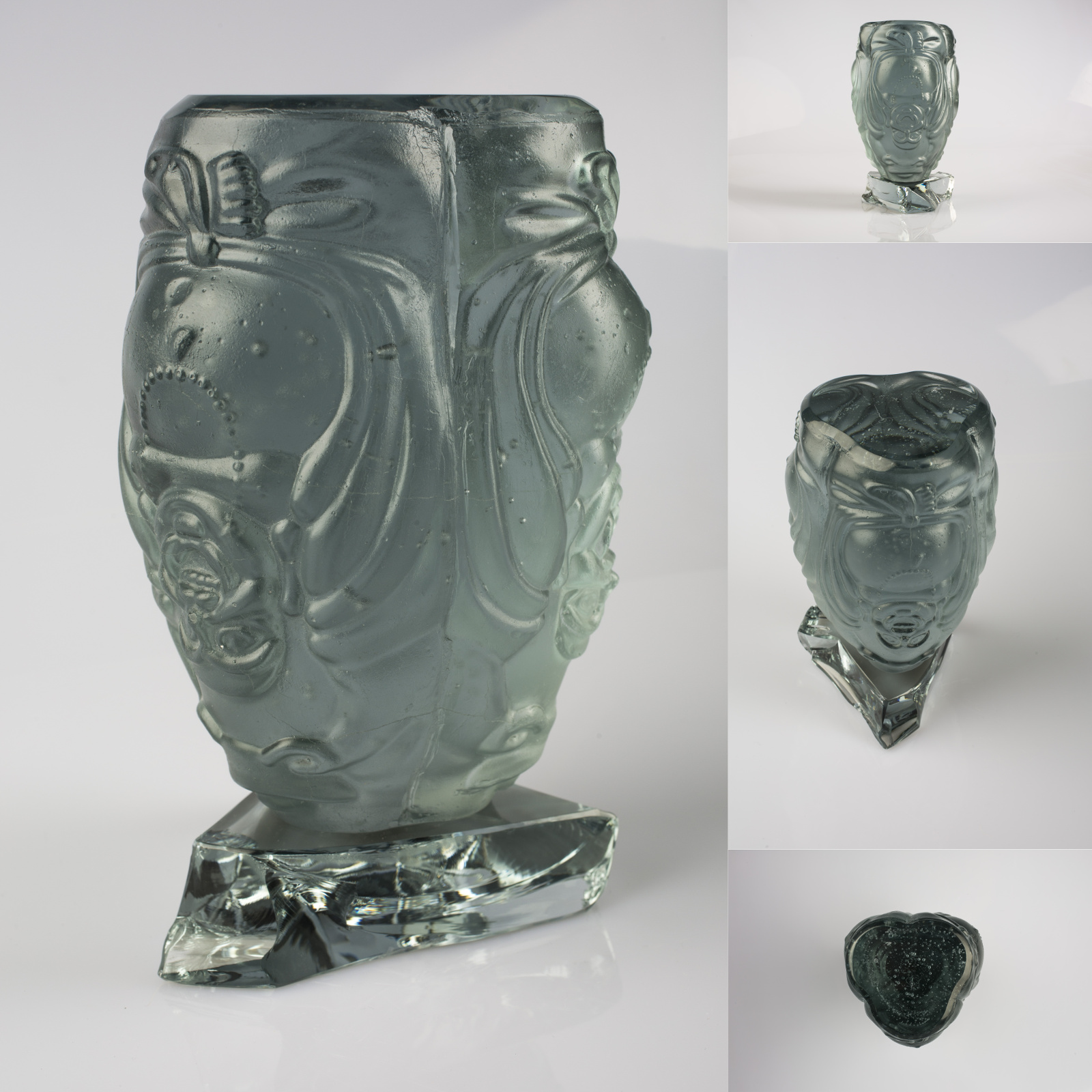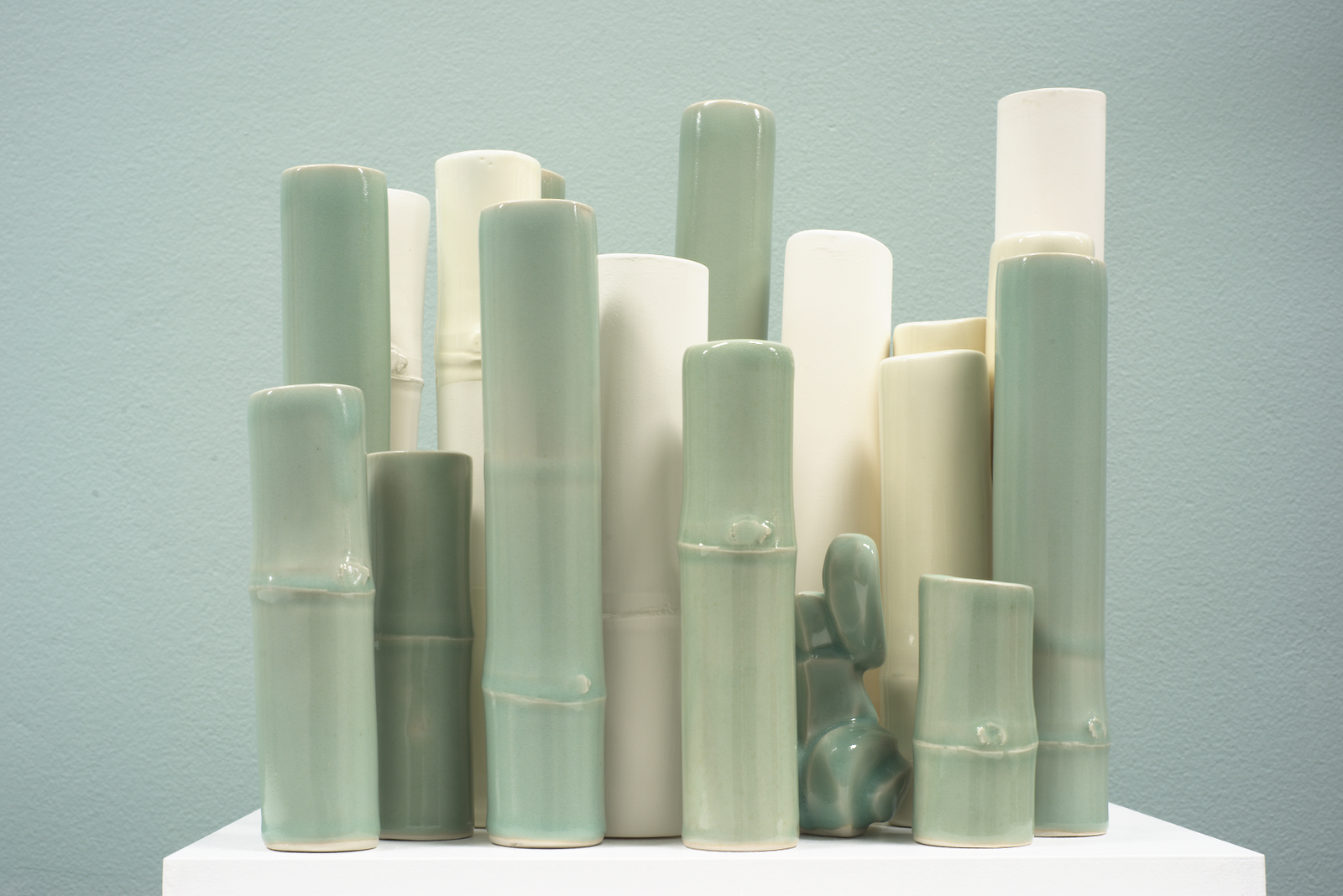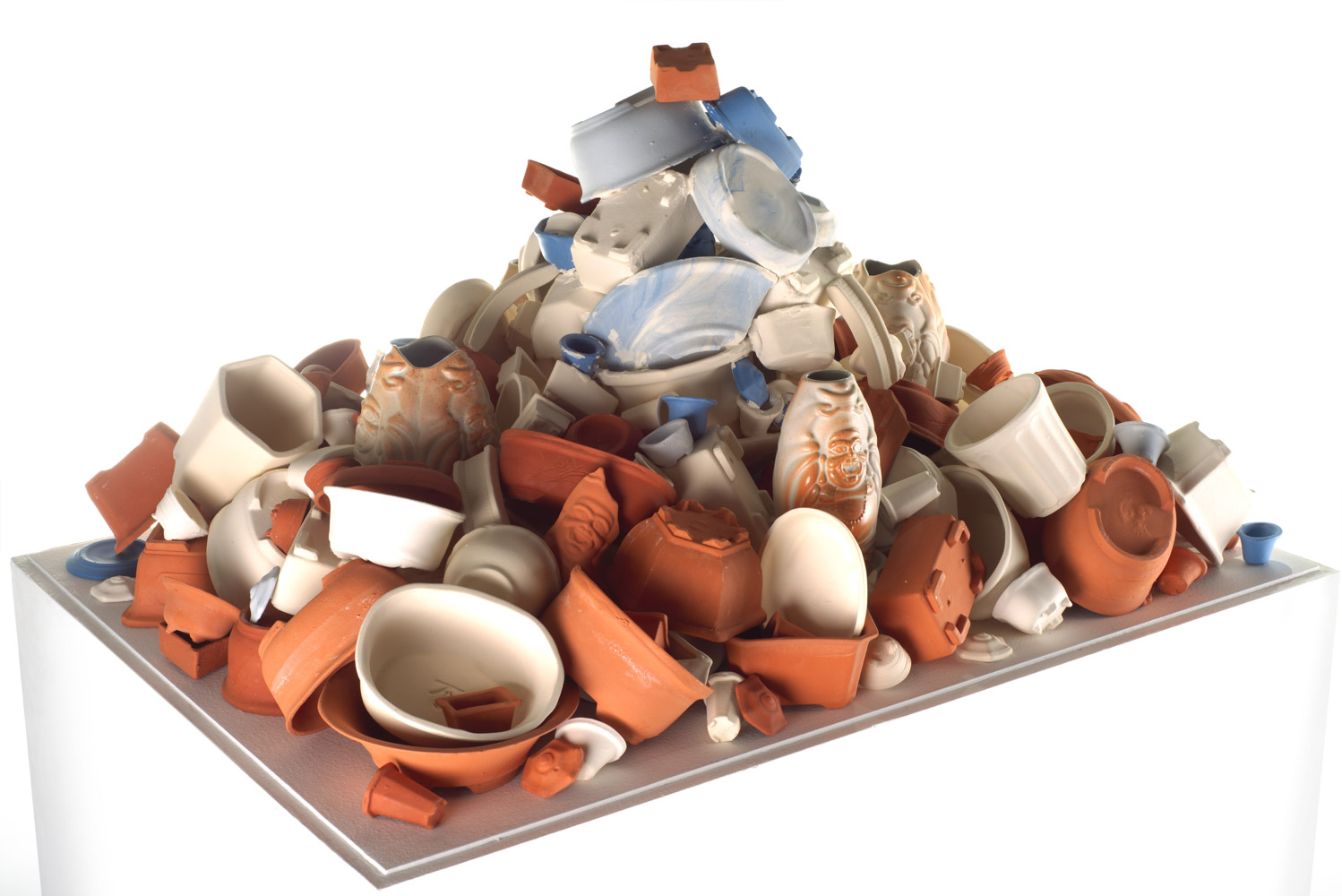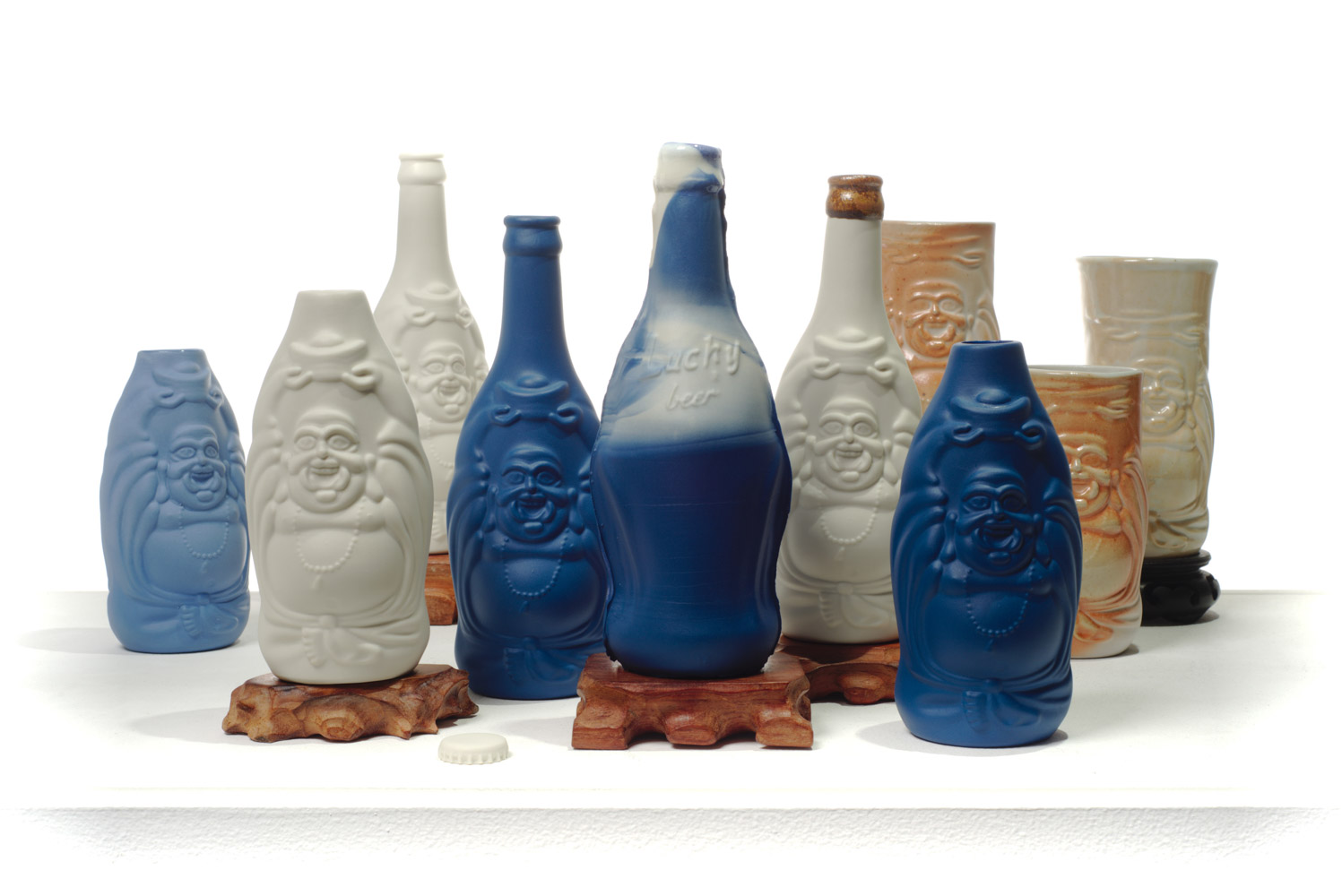
TV screen Buddha: Ode to Nam June Paik
In 2013, the artist NOT began his current project of returning a mass-produced image of the Buddha for popular consumption to the realm of the particular and the handmade, beginning in the ceramic medium at a time when ‘wonky pots’ were considered ‘the new video’. With TV screen Buddha: Ode to Nam June Paik (2017), the artist continues the handmade process through the medium of solid hot-formed, cold-worked glass from recycled TV screens in a unique artwork created at Canberra Glassworks. Referencing Nam June Paik’s ‘TV Buddha’ series, and in particular the father of video art’s Standing Buddha with Outstretched Hand (2005), NOT deliberately inverts his three-sided Buddha, perched on a polished shard of TV screen, and asks us to pause and internalise the perpetual self-reflexivity of the moving image, reducing an endlessly perpetuating subject to the singularity of the object. Here the medium becomes the message, transmitting eternity through the swirls of tiny, light-refracting bubbles of glass.

Last Man Standing
The dizzying sensation of standing on bamboo scaffolding high up in an apartment development in Hong Kong was the stepping-off point for Last Man Standing (2016), an installation comprising stoneware, porcelain and earthenware elements with clear and celadon glazes. For NOT, the feeling of vertigo has become a sense memory; it helps imbue this ceramic meditation on the dizzying speed of development currently transforming the artist’s home city of Sydney with an elegiac melancholy – as if Yang Fudong’s Seven Intellectuals in a Bamboo Forest (2003–07) has been reduced to a single, solitary figure.
在香港公寓发展中站立在竹脚手架上的令人眼花缭乱的感觉是“终极人站立”(2016年)的一个突破点,这个安装包括st瓷,瓷器和陶器元素,具有清澈的青瓷釉料。对于NOT,眩晕的感觉已经成为一种有意义的记忆;这有助于将陶瓷冥想放在令人眼花缭乱的发展速度上,目前正在改变艺术家的悉尼城市,令人难以置信 - 就像杨福东的七棵知识分子在竹林(2003-07)被简化为一个孤独的人物。

Angkor
During a ceramic residency at Gymea TAFE in 2014, the artist NOT was inspired by the donation of a variety of bonsai pot moulds that had been cleared from an original property being swamped by city development. As an artist naturally drawn to slipcasting, the moulds represented the slipping away of worlds, from the miniature to the mega-metropolis, from the old to the new. In the process of casting these moulds, NOT began slowly turning the process around. In Sanskrit, the word ‘stupa’ means to heap or pile, and for NOT the accumulation of pots forms something greater than its individual parts, evoking the ruins of the past leading up to the central stupa housing a Buddha, the last bastion of a disappearing world. These non-functional bonsai pots have been cast in coloured Limoges porcelain, stoneware and terracotta, each representing three of the colours of the Buddhist flag: blue (universal compassion), white (the purity of Dharma) and orange (wisdom). As so as the forms slowly slip from view, their essence reappears; what is lost returns.
藝術家 “不” 於2014年在吉梅亞職業技術和永續教育學院(Gymea TAFE)的陶藝所駐站時被所捐贈的各式各樣的盆景盆模所啟發,因著當時的都市更造計畫,進而有許多的老式住宅被淘汰。身為一位藝術家,“不” 很自然的被注漿成形法所含的寓意所吸引。盆景的盆模代表了一一消逝的世界,是一粒沙一個大千世界;是這個世代著急著以新汰舊。然而在注漿的過程當中,藝術家 “不” 開始漸漸地翻轉了這個局面。以梵語來說,窣堵坡(stupa)的意思是塔,或浮屠。對於藝術家 “不” 來說,堆積成山的盆所形成的意象超越了單單的個體戶,它喚醒了過去的荒蕪,其恭奉著以佛陀為中心的塔是在這個慢慢殆盡的世界裡幸所僅存的堡壘。這些不具功能性的盆景盆栽分別以有色的利摩日瓷器,陶石器,赤土陶器所注漿成形,每個顏色代表了佛教教幟的其中三色:藍色代表慈悲和和平,白色代表清境和解脫而橙色則是代表了智慧。如此一來,這件吳哥窟藝術作品的形式因為此觀點的轉換,其本質得以重現,所殆逝的也得以回歸淨土。

Buddha
Reversing the process that has seen images of the sacred Buddha reproduced on an array of mass-produced consumer items, and often carrying the moniker ‘made in China’, NOT returns the Buddha to the realm of the unique and the handmade. These slipcast Buddha vessels in porcelain both reference and erase the traces of their consumerable origins. They also smile and wink at the notion of ‘luck’, and the role that chance plays in the creation of these serendipitous objects, which are both sacred and profane. Indeed, ‘luck’ mocks their very reproducibility, as with each glaze and firing, these objects are reborn, uniquely ‘flawed’ and inscribed by their process. Slippage is also inherent in their form, as they quietly transform, from one- to three-sided Buddhas, inspired by the multi-dimensional representation of faith that emerges from the ruins of Angkor Thom.
藝術家 “不” 逆轉了因見證其莊嚴的佛像被大量且重複性的生產,漸而成為商品,並且被冠上中國製綽號的過程,讓佛陀回歸至獨特且手工的境界。這些佛陀瓶裝瓷器同時指出了,也抹滅了它們具有消費本質的證據。佛陀對著幸運之神微笑、眨眼,述說了機會在創造這樣具有偶然力性的作品所扮演的角色不僅是這麼莊嚴也褻瀆。確實,幸運之神嘲諷著它們極易的複製力,每當上一次釉彩和燒製,就代表了每重生一次,這樣的過程造就了獨特的不完美及深刻性。“不” 受到了柬埔寨吳哥窟遺跡裡的大吳哥城的啟發,它以多面的形象呈現對佛陀的信念的體現,藉著灌漿延移法在寂靜無聲的轉變中繼承了其形象,一面佛繼而浮現為三面佛。